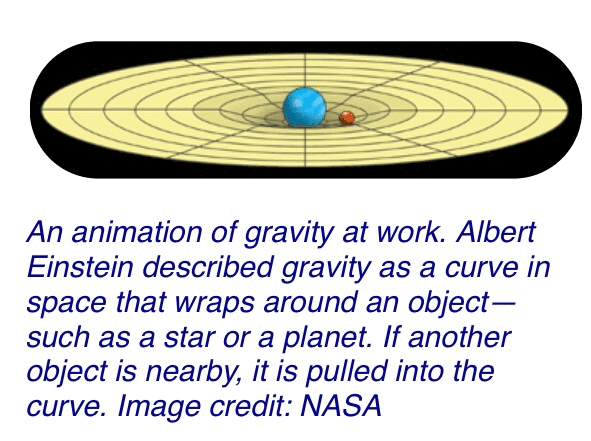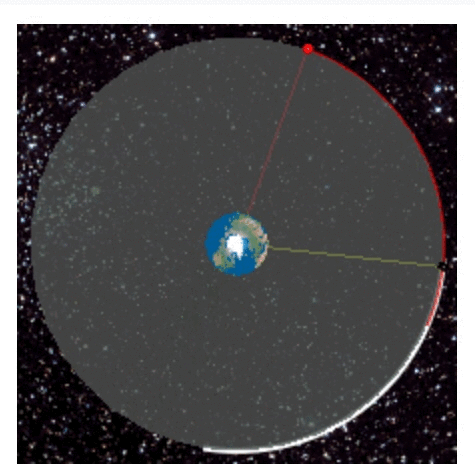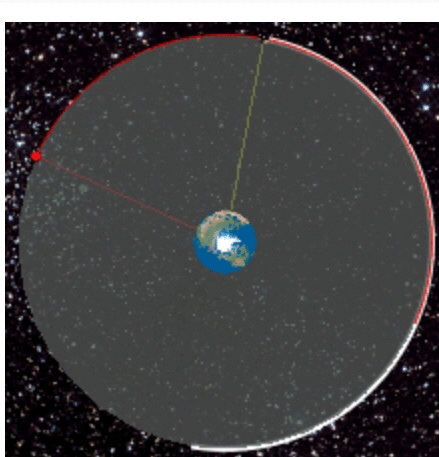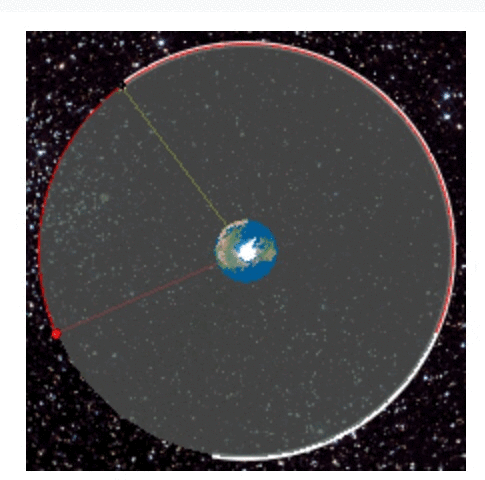It looks like you're using an Ad Blocker.
Please white-list or disable AboveTopSecret.com in your ad-blocking tool.
Thank you.
Some features of ATS will be disabled while you continue to use an ad-blocker.
share:
a reply to: InfiniteTrinity
If you are sitting down and stationary, you are technological geostationary. Does that mean the earth is not rotating about an axis? And that you are not “riding” the curved trajectory of the earth’s crust about the earth’s axis. So. By definition. A geostationary satellite has to be moving at a speed greater than the surface of the earth with a curved trajectory to stay geostationary above a specific spot on earth. Is that false.
If you are sitting down and stationary, you are technological geostationary. Does that mean the earth is not rotating about an axis? And that you are not “riding” the curved trajectory of the earth’s crust about the earth’s axis. So. By definition. A geostationary satellite has to be moving at a speed greater than the surface of the earth with a curved trajectory to stay geostationary above a specific spot on earth. Is that false.
originally posted by: InfiniteTrinity
a reply to: neutronflux
I dont have to debunk the service. I am not arguig against its existence.
Geostationary space satellites are debunked. Where you go from there is up to you.
Based on what? You telling yourself your wining?
a reply to: neutronflux
Can you say something relevant.
You only have to explain how geostationary sats maintain a curved trajectory through space, while being pulled down by gravity, without countering this by falling around Earth curvature.
Geostationary satellites debunked.
Can you say something relevant.
You only have to explain how geostationary sats maintain a curved trajectory through space, while being pulled down by gravity, without countering this by falling around Earth curvature.
Geostationary satellites debunked.
edit on 17-8-2019 by InfiniteTrinity because: (no reason given)
nm
edit on 17-8-2019 by InfiniteTrinity because: (no reason given)
originally posted by: InfiniteTrinity
a reply to: neutronflux
Can you say something relevant.
You only have to explain how geostationary sats maintain a curved trajectory through space, while being pulled down by gravity, without falling around Earth curvature.
Geostationary satellites debunked.
One...
You didn’t answer the question..,
If you are sitting down and stationary, you are technological geostationary. Does that mean the earth is not rotating about an axis? And that you are not “riding” the curved trajectory of the earth’s crust about the earth’s axis. So. By definition. A geostationary satellite has to be moving at a speed greater than the surface of the earth with a curved trajectory to stay geostationary above a specific spot on earth. Is that false.
Two...
The answers and sources were cited to you...
www.abovetopsecret.com...
From the launch vehicle that placed it in orbit like any other satellite. Except for correction thrust from a limited supply of fuel?
Let’s check a cited source...
science.howstuffworks.com...
Orbital Velocity and Altitude
PREVNEXT
A rocket must accelerate to at least 25,039 mph (40,320 kph) to completely escape Earth's gravity and fly off into space (for more on escape velocity, visit this article at NASA).
Earth's escape velocity is much greater than what's required to place an Earth satellite in orbit. With satellites, the object is not to escape Earth's gravity, but to balance it. Orbital velocity is the velocity needed to achieve balance between gravity's pull on the satellite and the inertia of the satellite's motion -- the satellite's tendency to keep going. This is approximately 17,000 mph (27,359 kph) at an altitude of 150 miles (242 kilometers). Without gravity, the satellite's inertia would carry it off into space. Even with gravity, if the intended satellite goes too fast, it will eventually fly away. On the other hand, if the satellite goes too slowly, gravity will pull it back to Earth. At the correct orbital velocity, gravity exactly balances the satellite's inertia, pulling down toward Earth's center just enough to keep the path of the satellite curving like Earth's curved surface, rather than flying off in a straight line.
The orbital velocity of the satellite depends on its altitude above Earth. The nearer to Earth, the faster the required orbital velocity. At an altitude of 124 miles (200 kilometers), the required orbital velocity is a little more than 17,000 mph (about 27,400 kph). To maintain an orbit that is 22,223 miles (35,786 kilometers) above Earth, the satellite must orbit at a speed of about 7,000 mph (11,300 kph). That orbital speed and distance permit the satellite to make one revolution in 24 hours. Since Earth also rotates once in 24 hours, a satellite at 22,223 miles altitude stays in a fixed position relative to a point on Earth's surface. Because the satellite stays right over the same spot all the time, this kind of orbit is called "geostationary." Geostationary orbits are ideal for weather satellites and communications satellites.
www.abovetopsecret.com...
You
How does it maintain it speed to maintain its trajectory through space if its in fact being pulled down by gravity.
Do some of your own research....
How Satellites Stay in Orbit
www.universetoday.com...
So really, a satellites ability to maintain its orbit comes down to a balance between two factors: its velocity (or the speed at which it would travel in a straight line), and the gravitational pull between the satellite and the planet it orbits. The higher the orbit, the less velocity is required. The nearer the orbit, the faster it must move to ensure that it does not fall back to Earth.
And satellites don’t always win the battle between forces....
After fighting a losing battle against gravity, the European Space Agency's GOCE satellite has made splashdown somewhere in the south Atlantic Ocean, says the ESA.
www.csmonitor.com...!-Falling-GOCE-satellite-lands-in-the-Atlantic
Looking forward to your well structured arguments with cited sources and cited evidence involving arguments against quoted statements from my sources to provide context which you disagree with.
a reply to: InfiniteTrinity
You just don’t get how sadly wrong you are? Really? Really Really? And that you have been repeatedly quoted to show how you contracted yourself? And the only thing you accomplished was moving the old proverbial goalpost around?
You just don’t get how sadly wrong you are? Really? Really Really? And that you have been repeatedly quoted to show how you contracted yourself? And the only thing you accomplished was moving the old proverbial goalpost around?
a reply to: neutronflux
Not this is not false. We have already been over this.
Are you now going to explain HOW geostationary sats maintain a curved trajectory through space, while being pulled down by gravity, without countering this by falling around Earth curvature like all satellites have to do.
A geostationary satellite has to be moving at a speed greater than the surface of the earth with a curved trajectory to stay geostationary above a specific spot on earth. Is that false.
Not this is not false. We have already been over this.
Are you now going to explain HOW geostationary sats maintain a curved trajectory through space, while being pulled down by gravity, without countering this by falling around Earth curvature like all satellites have to do.
edit on 17-8-2019 by InfiniteTrinity because: (no reason
given)
originally posted by: InfiniteTrinity
a reply to: neutronflux
A geostationary satellite has to be moving at a speed greater than the surface of the earth with a curved trajectory to stay geostationary above a specific spot on earth. Is that false.
Not this is not false. We have already been over this.
Are you now going to explain HOW geostationary sats maintain a curved trajectory through space, while being pulled down by gravity, without countering this by falling around Earth curvature like all satellites have to do.
The answers are cited and quoted to you.
Then quote the false statements from the cited sources that are wrong with a logical argument and evidence.
Not your BS argument you said so...
Again..
One...
You didn’t answer the question..,
If you are sitting down and stationary, you are technological geostationary. Does that mean the earth is not rotating about an axis? And that you are not “riding” the curved trajectory of the earth’s crust about the earth’s axis. So. By definition. A geostationary satellite has to be moving at a speed greater than the surface of the earth with a curved trajectory to stay geostationary above a specific spot on earth. Is that false.
Two...
The answers and sources were cited to you...
www.abovetopsecret.com...
From the launch vehicle that placed it in orbit like any other satellite. Except for correction thrust from a limited supply of fuel?
Let’s check a cited source...
science.howstuffworks.com...
Orbital Velocity and Altitude
PREVNEXT
A rocket must accelerate to at least 25,039 mph (40,320 kph) to completely escape Earth's gravity and fly off into space (for more on escape velocity, visit this article at NASA).
Earth's escape velocity is much greater than what's required to place an Earth satellite in orbit. With satellites, the object is not to escape Earth's gravity, but to balance it. Orbital velocity is the velocity needed to achieve balance between gravity's pull on the satellite and the inertia of the satellite's motion -- the satellite's tendency to keep going. This is approximately 17,000 mph (27,359 kph) at an altitude of 150 miles (242 kilometers). Without gravity, the satellite's inertia would carry it off into space. Even with gravity, if the intended satellite goes too fast, it will eventually fly away. On the other hand, if the satellite goes too slowly, gravity will pull it back to Earth. At the correct orbital velocity, gravity exactly balances the satellite's inertia, pulling down toward Earth's center just enough to keep the path of the satellite curving like Earth's curved surface, rather than flying off in a straight line.
The orbital velocity of the satellite depends on its altitude above Earth. The nearer to Earth, the faster the required orbital velocity. At an altitude of 124 miles (200 kilometers), the required orbital velocity is a little more than 17,000 mph (about 27,400 kph). To maintain an orbit that is 22,223 miles (35,786 kilometers) above Earth, the satellite must orbit at a speed of about 7,000 mph (11,300 kph). That orbital speed and distance permit the satellite to make one revolution in 24 hours. Since Earth also rotates once in 24 hours, a satellite at 22,223 miles altitude stays in a fixed position relative to a point on Earth's surface. Because the satellite stays right over the same spot all the time, this kind of orbit is called "geostationary." Geostationary orbits are ideal for weather satellites and communications satellites.
www.abovetopsecret.com...
You
How does it maintain it speed to maintain its trajectory through space if its in fact being pulled down by gravity.
Do some of your own research....
How Satellites Stay in Orbit
www.universetoday.com...
So really, a satellites ability to maintain its orbit comes down to a balance between two factors: its velocity (or the speed at which it would travel in a straight line), and the gravitational pull between the satellite and the planet it orbits. The higher the orbit, the less velocity is required. The nearer the orbit, the faster it must move to ensure that it does not fall back to Earth.
And satellites don’t always win the battle between forces....
After fighting a losing battle against gravity, the European Space Agency's GOCE satellite has made splashdown somewhere in the south Atlantic Ocean, says the ESA.
www.csmonitor.com...!-Falling-GOCE-satellite-lands-in-the-Atlantic
Looking forward to your well structured arguments with cited sources and cited evidence involving arguments against quoted statements from my sources to provide context which you disagree with.
edit on 17-8-2019 by neutronflux because: Added and fixed
a reply to: neutronflux
A geostationary satellite doesnt orbit the planet.
What is this 70 times now?
Debunked.
So really, a satellites ability to maintain its orbit comes down to a balance between two factors: its velocity (or the speed at which it would travel in a straight line), and the gravitational pull between the satellite and the planet it orbits.
A geostationary satellite doesnt orbit the planet.
What is this 70 times now?
Debunked.
originally posted by: neutronflux
a reply to: InfiniteTrinity
Your just sad. Just plain sad.
Why dont you try not to contradict yourself with the same thing 70 times.
Is everything falling?
Are all satellites constantly falling ?
Is the Earth falling towards the Sun ?
Is our Sun falling towards the center of the Milky-Way ?
Is our Galaxy falling towards some other gravity well ?
Is everything falling towards some supposed gravitational 'center' ?
Are we falling out of our chair, but are counterbalanced, by the physics of the chair, and/or the whatever circumstances ?
Are we falling out-of bed, while sleeping ?
Everything Falling
Are all satellites constantly falling ?
Is the Earth falling towards the Sun ?
Is our Sun falling towards the center of the Milky-Way ?
Is our Galaxy falling towards some other gravity well ?
Is everything falling towards some supposed gravitational 'center' ?
Are we falling out of our chair, but are counterbalanced, by the physics of the chair, and/or the whatever circumstances ?
Are we falling out-of bed, while sleeping ?
Everything Falling
a reply to: InfiniteTrinity
Your sad
Again...
And Again...
From the earth’s surface. A geostationary satellite appears to be “fixed”. But that same satellite is traveling the “curve” of earth’s gravity well. Orbiting around the center of earth’s gravity well. If you use the earth’s axis as a fixed point of origin, you can solve for the angular momentum of a geostationary / geosynchronous satellite.
You
The only thing dumb is that you cannot realize the earth’s rotation has nothing to do with earth’s gravity well. And it’s ”dumb” that you think a satellite cannot be in orbit because it is at a height and speed that matches the earth’s rotation.
First off, the earth’s rotation has nothing to do with the ability of a satellite to orbit. In reality, a satellite does not orbit the center of the earth. A satellite orbits the center of Earth’s gravity well. An orbiting satellite could careless if the earth was rotating, and at what speed.
Second: Why can you not get through your head a geostationary/ geosynchronous still obits the earth. It’s just at a speed that keeps it above a specific point and n earth. But a geostationary / geosynchronous satellite is still traveling around earth’s gravity well.
Your sad
Again...
And Again...
From the earth’s surface. A geostationary satellite appears to be “fixed”. But that same satellite is traveling the “curve” of earth’s gravity well. Orbiting around the center of earth’s gravity well. If you use the earth’s axis as a fixed point of origin, you can solve for the angular momentum of a geostationary / geosynchronous satellite.
You
You guys are hilarious. You keep posting the same dumb contradiction I debunked about 40 times now.
The only thing dumb is that you cannot realize the earth’s rotation has nothing to do with earth’s gravity well. And it’s ”dumb” that you think a satellite cannot be in orbit because it is at a height and speed that matches the earth’s rotation.
First off, the earth’s rotation has nothing to do with the ability of a satellite to orbit. In reality, a satellite does not orbit the center of the earth. A satellite orbits the center of Earth’s gravity well. An orbiting satellite could careless if the earth was rotating, and at what speed.
What is gravity?
spaceplace.nasa.gov...
Second: Why can you not get through your head a geostationary/ geosynchronous still obits the earth. It’s just at a speed that keeps it above a specific point and n earth. But a geostationary / geosynchronous satellite is still traveling around earth’s gravity well.
Geostationary orbit
en.m.wikipedia.org...
A geostationary orbit, often referred to as a geosynchronous equatorial orbit[1] (GEO), is a circular geosynchronous orbit 35,786 km (22,236 mi) above Earth's equator and following the direction of Earth's rotation. An object in such an orbit appears motionless, at a fixed position in the sky, to ground observers. Communications satellites and weather satellites are often placed in geostationary orbits, so that the satellite antennas (located on Earth) that communicate with them do not have to rotate to track them, but can be pointed permanently at the position in the sky where the satellites are located. Using this characteristic, ocean-color monitoring satellites with visible and near-infrared light sensors (e.g. GOCI) can also be operated in geostationary orbit in order to monitor sensitive changes of ocean environments.
edit on 17-8-2019 by neutronflux because: Added and fixex
a reply to: neutronflux
The dumb thing is that I still didnt make any such claims. Said that what 5 times now?
Sigh, 71.
Of teh gravity well? I dont think you realize what that really means.
The only thing dumb is that you cannot realize the earth’s rotation has nothing to do with earth’s gravity well.
The dumb thing is that I still didnt make any such claims. Said that what 5 times now?
Second: Why can you not get through your head a geostationary sat still obits the earth. It’s just at a speed that keeps it above a specific point and n earth.
Sigh, 71.
From the earth’s surface. A geostationary satellite appears to be “fixed”. But that same satellite is traveling the “curve” of earth’s gravity well.
Of teh gravity well? I dont think you realize what that really means.
edit on 17-8-2019 by InfiniteTrinity because: (no reason given)
a reply to: InfiniteTrinity
Care to actually quote what you believe is wrong? And create a logical argument with evidence? Or you just going to keep your eyes shut with your fingers in your ears screaming debunked debunked debunked debunked.....
Care to actually quote what you believe is wrong? And create a logical argument with evidence? Or you just going to keep your eyes shut with your fingers in your ears screaming debunked debunked debunked debunked.....
a reply to: InfiniteTrinity
And you didn’t answer....
If you are sitting down and stationary, you are technological geostationary. Does that mean the earth is not rotating about an axis? And that you are not “riding” the curved trajectory of the earth’s crust about the earth’s axis. So. By definition. A geostationary satellite has to be moving at a speed greater than the surface of the earth with a curved trajectory to stay geostationary above a specific spot on earth. Is that false.
And you didn’t answer....
If you are sitting down and stationary, you are technological geostationary. Does that mean the earth is not rotating about an axis? And that you are not “riding” the curved trajectory of the earth’s crust about the earth’s axis. So. By definition. A geostationary satellite has to be moving at a speed greater than the surface of the earth with a curved trajectory to stay geostationary above a specific spot on earth. Is that false.
a reply to: neutronflux
Pretty sure I did.
Try to register something.
And you didn’t answer....
Pretty sure I did.
Not this is not false. We have already been over this.
Try to register something.
originally posted by: neutronflux
a reply to: InfiniteTrinity
Care to actually quote what you believe is wrong? .
The fact that you still have to ask this after 100 times about sums you up.
a reply to: InfiniteTrinity
Ether answer or provide the link to your answer...
Again...
And you didn’t answer....
If you are sitting down and stationary, you are technological geostationary. Does that mean the earth is not rotating about an axis? And that you are not “riding” the curved trajectory of the earth’s crust about the earth’s axis. So. By definition. A geostationary satellite has to be moving at a speed greater than the surface of the earth with a curved trajectory to stay geostationary above a specific spot on earth. Is that false.
Ether answer or provide the link to your answer...
Again...
And you didn’t answer....
If you are sitting down and stationary, you are technological geostationary. Does that mean the earth is not rotating about an axis? And that you are not “riding” the curved trajectory of the earth’s crust about the earth’s axis. So. By definition. A geostationary satellite has to be moving at a speed greater than the surface of the earth with a curved trajectory to stay geostationary above a specific spot on earth. Is that false.
edit on 17-8-2019 by neutronflux because: Added quote
a reply to: neutronflux
What part of "no this is not false" eludes your brain?
Whats this one 4 times now?
Are you feeling allright?
And you didn’t answer....
What part of "no this is not false" eludes your brain?
Whats this one 4 times now?
Are you feeling allright?
new topics
-
Slap in the Face for Starmer - Trump Could / Should Block Chagos Islands Deal
Regional Politics: 2 minutes ago -
Boots Hire Racist for Sexist Christmas advert 2024
Social Issues and Civil Unrest: 1 hours ago -
Dems during OBAMA Regime granted $3.7 million to Wuhan Institute of Virology.
Diseases and Pandemics: 2 hours ago -
FEMA skip the houses with a Trump sign
Social Issues and Civil Unrest: 5 hours ago -
Oligarchy It Is Then
Short Stories: 7 hours ago -
My Call for Donald Trumps Very First Official Act in 2025
2024 Elections: 9 hours ago -
The JAN 6th 2021 U.S. Capitol Unrest Charges Against Former President TRUMP Were Dropped Today.
US Political Madness: 10 hours ago
top topics
-
FEMA skip the houses with a Trump sign
Social Issues and Civil Unrest: 5 hours ago, 17 flags -
My Call for Donald Trumps Very First Official Act in 2025
2024 Elections: 9 hours ago, 11 flags -
The JAN 6th 2021 U.S. Capitol Unrest Charges Against Former President TRUMP Were Dropped Today.
US Political Madness: 10 hours ago, 7 flags -
Dems during OBAMA Regime granted $3.7 million to Wuhan Institute of Virology.
Diseases and Pandemics: 2 hours ago, 7 flags -
Oligarchy It Is Then
Short Stories: 7 hours ago, 5 flags -
Slap in the Face for Starmer - Trump Could / Should Block Chagos Islands Deal
Regional Politics: 2 minutes ago, 2 flags -
Boots Hire Racist for Sexist Christmas advert 2024
Social Issues and Civil Unrest: 1 hours ago, 1 flags
active topics
-
Mother Sentenced to over 2 years for Shouting at police During Disorder
Social Issues and Civil Unrest • 20 • : worldstarcountry -
On Nov. 5th 2024 - AMERICANS Prevented the Complete Destruction of America from Within.
2024 Elections • 138 • : cherokeetroy -
Slap in the Face for Starmer - Trump Could / Should Block Chagos Islands Deal
Regional Politics • 0 • : gortex -
leftwing wymen shaving their head in protest
US Political Madness • 84 • : MetalThunder -
10 Forward
Television • 150 • : worldstarcountry -
Russia Ukraine Update Thread - part 3
World War Three • 6751 • : Oldcarpy2 -
Post A Funny (T&C Friendly) Pic Part IV: The LOL awakens!
General Chit Chat • 7759 • : underpass61 -
Oligarchy It Is Then
Short Stories • 8 • : FullHeathen -
Leaving the US due to severe TDS?
US Political Madness • 34 • : network dude -
President-Elect DONALD TRUMP's 2nd-Term Administration Takes Shape.
Political Ideology • 69 • : cherokeetroy





